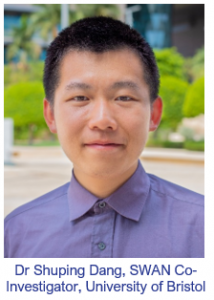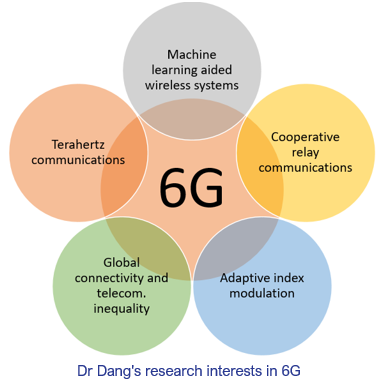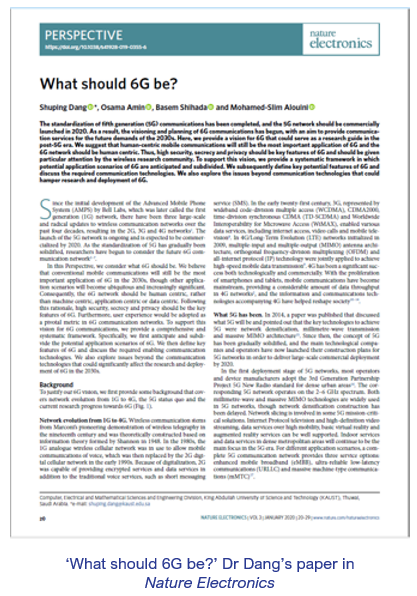Alongside our team of post-doctoral researchers, PhD students, and industrial experts, SWAN also benefits from the expertise of aligned academics at the University of Bristol.
Dr Shuping Dang , Lecturer at the University of Bristol, joined the CSN research group and Smart Internet Lab in June 2021. Since then, he has been contributing to the SWAN project as a Co-Investigator. In our next research spotlight blog, we asked Shuping about his research experience in machine learning for communications and the role he has played in the SWAN project over the last nine months.
, Lecturer at the University of Bristol, joined the CSN research group and Smart Internet Lab in June 2021. Since then, he has been contributing to the SWAN project as a Co-Investigator. In our next research spotlight blog, we asked Shuping about his research experience in machine learning for communications and the role he has played in the SWAN project over the last nine months.
Can you tell us a little bit about your own research interests and background?
I received B.Eng (Hons) in Electrical and Electronic Engineering from the University of Manchester (with first class honours) and B.Eng in Electrical Engineering and Automation from Beijing Jiaotong University in 2014 via a joint ‘2+2’ dual-degree program. I also received D.Phil in Engineering Science from University of Oxford in 2018. I then joined in the R&D Center, Huanan Communication Co., Ltd. after graduating from University of Oxford and then worked as a Postdoctoral Fellow at King Abdullah University of Science and Technology (KAUST). I am currently a Lecturer with Department of Electrical and Electronic Engineering, University of Bristol. My research interests include 6G communications, wireless communications, wireless security, and machine learning for communications.
How does your research experience align with SWAN’s programme of research?

My research work in recent years is highly related to the programme objectives of SWAN. In order to enhance wireless security and develop advanced detection and countermeasure mechanisms against various attacks aimed at the radio interface, higher degrees of network reliability, flexibility, and adaptability are imperative. My recent work on cascaded neural computing, distributed networking, and AI for wireless communications would help equip wireless networks with intelligent functionality and realise the key principles of secure design.
As a member of SWAN’s academic team, what have been your key responsibilities so far with the project?
I am currently supervising/co-supervising a PhD candidate and an MSc student whose research topics are relevant to SWAN. I have also been involved in a variety of SWAN’s research activities and have provided guidance for other SWAN PhD students and Senior Research Associates.
Alongside this, I am investigating some interesting topics within the framework of SWAN, e.g., federated learning and physical-layer security for novel communication paradigms (RIS, UAV, mmWave, THz and so on).
In terms of administrative duties, I participated in several recruitment panels for hiring PhD(s) and Research Associate(s) for SWAN.
Can you give us a brief overview of the work packages you have been involved with?
- Design and optimise novel federated learning based communication networks.
- Analyse physical-layer security for RIS-aided communications.
- Analyse physical-layer security for UAV-aided communications (with a SWAN PhD).
- Analyse physical-layer security for terahertz communications (with incoming MSc students).
- Develop new computing techniques for wireless security (with an undergraduate student).
Where does this work fit in with SWAN’s wider Research Challenges?
Most of my work packages fall into the categories of RC3 (Cyber Secure Radio Design) and RC4 (Secure Dynamic Spectrum Access). I try to quantify the physical-layer security metrics and understand the features of several novel communication paradigms, aiming to provide better countermeasures against wireless attacks.
What will be the next steps and key outputs for the work packages you have been involved with?
- Design and optimise novel federated learning based communication networks: A full journal submission to IEEE Internet of Things Journal or IEEE Transactions on Dependable and Secure Computing by the end of 2022.
- Analyse physical-layer security for RIS-aided communications: A full journal submission to IEEE Transactions on Information Forensics and Security by the end of 2022.
- Analyse physical-layer security for UAV-aided communications (with a SWAN PhD): A letter submission to IEEE Wireless Communications Letters by the end of 2022.
- Analyse physical-layer security for terahertz communications (with incoming MSc students): A conference submission to IEEE ICC or WCNC 2023.
- Develop new computing techniques for wireless security (with an undergraduate student): A conference submission to IEEE ICC or WCNC 2023.
In your opinion, what are the key benefits of industry and academia working so closely together?
Communications engineering, though it is occasionally referred to as ‘communications science’, is different from basic sciences. The only goal of communications engineering is to make information transmission more efficient and more secure. Therefore, although tentative technological innovations either in theory or in practice should always be encouraged, purely theoretical research of communications engineering that cannot reach end users and make a difference is insufficient.
Accordingly, the ultimate, essential, and unchanged touchstone of the usefulness of a communications technology is acceptance at market level. Industrial partners can help academics understand the non-technological factors better when pursuing the technological perfection, e.g., demands, costs, market discipline, and various human factors.
Can you tell us of one recent publication in the world of communications systems and networks research that has interested you?
In my recent publication co-authored with researchers from University of Southern California and South China University of Technology (S. Shaham, S. Dang, M. Wen, S. Mumtaz, V. G. Menon and C. Li, "Enabling Cooperative Relay Selection by Transfer Learning for the Industrial Internet of Things," in IEEE Transactions on Cognitive Communications and Networking, 2022 (early access article)), we proposed a generic transfer learning framework for relay selection problems in the industrial IoT. To the best of my knowledge, this is the first paper that models and analyses the neural network output errors as random variables.
We are also trying to construct and generalise the statistical connection between random inputs and output errors. Such a generic framework can be even extended to help with other wireless optimisation problems incorporating security factors. Further studies are on the way.
Is there anything else you would like to tell us?
As I expressed in my vision article "What Should 6G be?" published in Nature Electronics (S. Dang, O. Amin, B. Shihada, and M.-S. Alouini, “What should 6G be?” Nature Electronics, vol. 3, no. 1, pp. 20–29, 2020), the security, secrecy and privacy issues of wireless communications have been, to some extent, overlooked in the past decades. We suggest that high security, secrecy and privacy should be the key features of 6G, and should be given particular attention by the wireless research community.
SWAN Prosperity Partnership
SWAN is an EPSRC Prosperity Partnership project dedicated to the creation of Secure Wireless Agile Networks (SWAN) that are resilient to both cyber attacks and accidental or induced failures. The partnership is made up of contributors from the Smart Internet Lab at the University of Bristol, Toshiba Research Europe Ltd, GCHQ, and Roke Manor Research Ltd.
Interested in reading more about SWAN and our programme of research? Take a look at our website for more information or sign up to our newsletter for regular updates on SWAN activities and opportunities to get involved.

